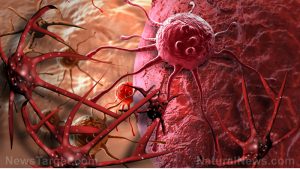
Embryonal rhabdomyosarcoma – causes, side effects and treatments at NaturalPedia.com
Wednesday, March 14, 2018 by Edsel Cook
http://www.naturalpedia.com/embryonal-rhabdomyosarcoma-causes-side-effects-and-treatments-at-naturalpedia-com.html

Embryonal rhabdomyosarcoma (ERMS) is a rare type of cancerous growth made up of skeletal muscles that grow alongside a child’s normal muscles. It is a slow-growing cancer that often develops in small muscles, such as the head and neck regions.
It’s also known as embryonal sarcoma, malignant rhabdomyoma, rhabdopoietic sarcoma, and rhabdo. It occurs in infants and toddlers less than six years old.

Known side effects of embryonal rhabdomyosarcoma
The following risk factors are linked to embryonal rhabdomyosarcoma:
- Li-Fraumeni syndrome is a rare genetic disorder that increases the risk of cancer.
- Neurofibromatosis is a condition that causes tumor growth on nerve tissue.
- Beckwith-Wiedemann syndrome is a congenital disorder responsible for uncontrolled growth in the internal organs and other parts of the body.
- Costello syndrome and Noonan syndrome can cause deformities and other problems that may lead to tumor development.
- Possibly caused by exposure to X-rays.
- Possibly caused by parental use of cocaine, marijuana, and drugs.
The following side effects may result because of embryonal rhabdomyosarcoma:
- Constant lump or swelling in a body part. Pain may occur in affected part.
- Proptosis (bulging eye) or ptosis (drooping eyelid)
- Headache and nausea
- Difficult urination or bowel movements
- Traces of blood in the urine or poop
- Earache or sinus infections
- Bleeding from the nostrils, throat, vagina, or rectum
- Constipation, pain in the abdomen, and vomiting
Body systems harmed by embryonal rhabdomyosarcoma
Embryonal rhabdomyosarcoma can develop in most any part of the body, so it can potentially affect a multitude of systems and organs.
Nose and throat tumors can eventually reach the central nervous system. Tumors near the eyes will affect the ocular system, while ear tumors will affect the auditory system. Bladder and vaginal tumors put the excretory system at risk. Finally, muscle tumors will cause pain in the part of the muscular system they are found.
Food and nutrients that may prevent embryonal rhabdomyosarcoma
As embryonal rhabdomyosarcoma is a type of cancer, Organic Facts lists a number of cancer-preventing foods that could protect your child.
Ginseng encourages disease resistance and repels infectious pathogens. This is especially important as the immune system of a young child is very weak.
Consuming wheatgrass will likewise improve the immune system, cleanse the body, and delay the growth of cancer. It can be eaten raw, but your child would probably prefer it as a juice.
Freshly-squeezed juices from fruits like apples, bananas, mangoes, and cherries should be given to your child. The vitamins and minerals in fresh fruit juice reinforces the immune system.
Vegetable soups are good for people seeking to avoid cancer. Bananas, carrots, corn, peas, and spinach are highly recommended.
Treatments, management plans for embryonal rhabdomyosarcoma
If a child is afflicted with embryonal rhabdomysarcoma, experts will study the location of the tumor in order to determine the best treatment.
The most common method of removing the tumor is a surgical operation called a “wide local incision.” More than one surgery is performed, and in many cases some malignant growth remains.
If the tumor is near the eyes or the genital areas, the doctors perform a biopsy instead. Chemotherapy and radiotherapy may be administered before or after the operation.
More serious cases need chemotherapy, radiation therapy, immunotherapy, or targeted therapy. The most extreme and rarest cases call for high-dose chemotherapy and stem cell transplant.
Where to learn more
- Young mom learns she may die of cancer after doctor misdiagnosed and put her through unnecessary chemo
- Tommy Chong beats prostate cancer with hemp oil and proper diet
- Stage-3 myeloma cancer completely ELIMINATED with a turmeric supplement – British Medical Journal
- Skyrocketing cancer rates driven by processed food, warn researchers
- Oldest Cancer Case Ever Discovered Showed Signs of Tooth Decay
Summary
Embryonal rhabdomysarcoma is a malignant tumor that forms when skeletal muscles grow out of control on a child’s body.
Embryonal rhabdomysarcoma is known to cause lumps and swelling, proptosis and ptoasis, headache and nausea, difficulty in urination and excretion, blood in waste products, earache, sinus infections, bleed, constipation, abdominal pain, and vomiting.
Embryonal rhabdomysarcoma can appear on most parts of the body.
The foods that can help prevent or manage are ginseng, wheatgrass, fresh fruits, and cancer-preventing vegetables.
Embryonal rhabdomysarcoma can be managed through surgeries, chemotheraphy, radiation therapy, immunotherapy, targeted therapy, and stem cell transplant.
Sources include:
Tagged Under: Tags: Embryonal rhabdomyosarcoma





